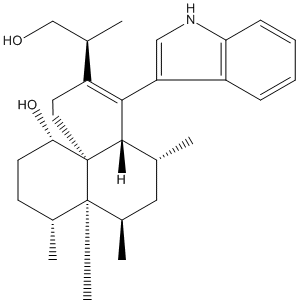ID 2: 74
Toxin: n
Trivial name:
1H-Benzo[d]naphthalene-1,5-diol, 2,3,4,4a,5,6,7,7a,10,11-decahydro-9-(2-hydroxy-1-methylethyl)-8-(1H-indol-3-yl)-4,4a,7-trimethyl-, [1α,4α,4aα,5β,7α,7aβ,9(R*),11aR*]-; 20,26-Dihydroxyaflavinine; Aflavinine, dihydroxy-; Dihydroxyaflavinine
Systematic name:
1H-Benzo[d]naphthalene-1,5-diol, 2,3,4,4a,5,6,7,7a,10,11-decahydro-9-(2-hydroxy-1-methylethyl)-8-(1H-indol-3-yl)-4,4a,7-trimethyl-, [1a,4a,4aa,5b,7a,7ab,9(R*),11aR*]-
Molecular formulae:
C28H39NO3
Molecular weight: 437.61
Chemical abstract number: 76410-56-5
Literature reference:
References URL:
Aspergillus Species known to produce this metabolite:
Toxicity:
Insecticide
Structure image:

Date uploaded: 2008-07-07 16:08:30
Mycotoxin & Metabolites
-
Metabolite
Produced by (species)
Molecular weight
References
-
399.0
428.5
445.5
443.5
321.5
138.1
264.3
138.1
182.2
Mycotoxin & Metabolite database
Aspergillus species produce a large number of secondary metabolites, sometimes referred to as extrolites. We attempt to list them all here and we also collect published papers.
Search Metabolite papers here
